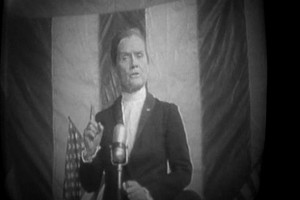Death Race 2000 – 1975
“I need not describe the feelings of those whose dearest ties are rent by that most irreparable evil, the void that presents itself to the soul, and the despair that is exhibited on the countenance.” — Mary Shelley, Frankenstein.
“Frankenstein! Frankenstein the legend! Frankenstein the indestructible! Sole survivor of the titanic pile-up of ’95. Only two time winner of the Trans Continental Road Race. Frankenstein! Ripped up, wiped out, battered, shattered, creamed and reamed! A dancer on the brink of death!” — Junior Bruce, Death Race 2000.
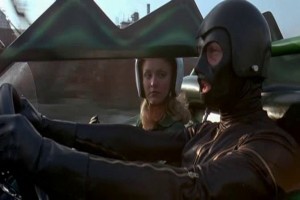
I was going to write about Victor Frankenstein this week, before I remembered that, duh, the DVD isn’t out yet so I can’t get any screenshots. Since the best part of Victor Frankenstein is the visuals, I think I’ll leave that one for now. Never mind, though, I have something almost as silly: Death Race 2000! What’s that, you ask? Well, if you imagine something like a cross between The Hunger Games and The Wacky Races then, that’s basically Death Race 2000, except that…
No, on second thoughts, I take that back. There is no ‘except that’. Death Race 2000 is exactly like a Hunger Games/Wacky Races mash up, no exceptions. It’s also produced by Roger Corman, which means it could go either way, quality wise. Which way does it go? Let’s find out.
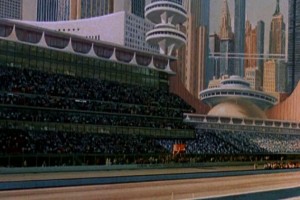
In the distant future year 2000, the sinister Mr President (Sandy McCallum) runs an evil government that has taken over the USA. Mr President does generalised, unspecified evil things and maintains his power over the people by means of an annual of the Trans Continental Road Race. In this event, five cars race from New York to New Los Angeles, scoring points on the way by running people over.
The drivers of these cars are great celebrities with legions of admirers. Each of them has some sort of amusing branded persona. There’s Calamity Jane (Mary Woronov), a cowgirl who drives a car made up to look like a bull, Nazi-themed driver Matilda the Hun (Roberta Collins) in her Buzz-bomb, and Roman-themed Nero the Hero (Martin Kove) whose car looks like a lion. Next up is Machine-gun Joe — played by an actor who I initially thought was doing a really good Sylvester Stallone impression. Later, I realised that it actually was Sylvester Stallone a few years before he hit it big with Rocky. Joe drives a mob-themed car, bedecked with machine-guns and giant knives and is one of only two survivors of previous races.
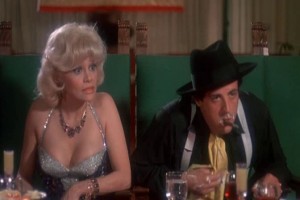
The other survivor, the hero of many races, the idol of millions is the great racer known as — Frankenstein (David Carradine). He’s so called because he’s been injured countless times and sewn back together, each time better than before. Frankenstein is lauded by the press, proclaimed a close personal friend of Mr President and is certainly the one to beat in the TCRR of the year 2000.
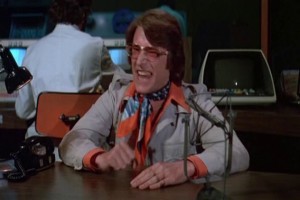
I might cut down my usual recap of the plot, because there isn’t much of one. The drivers head west, crushing pedestrians as they go, but are themselves being picked off by the anti-Mr President resistance run by the schoolmarmish Thomasina Paine. There’s quite a lot of violence, but it’s all too cartoonish to take seriously, though perhaps it was shocking in its time. Frankenstein’s navigator, Alice, turns out to be working for the resistance, but then so does Frankenstein. It turns out that Frankenstein isn’t in fact a racecar driver who’s been rebuilt dozens of times, he’s a ward of the state trained in a secret government training centre. When one ‘Frankenstein’ dies, he’s replaced by the next one. This Frankenstein plans to be the last of the line. His supposed cybernetic implants do not exist, but he does have an artificial hand containing an explosive device – a ‘hand grenade’.

This is the best joke in the movie. That’s not meant as faint praise by the way, I think that’s an awesome joke. Wish I’d thought of it.
Frankenstein’s navigator Annie (Simone Griffeth) uses the hand grenade to kill Machine-Gun Joe before Joe can kill Frankenstein. Lacking a weapon with which to kill the President, Frankenstein tries to stab him, but is shot and wounded by Thomasina Paine before he can do so. It is revealed that this is not really Frankenstein, just Annie in disguise. The real Frankenstein, now naked (way more of David Carradine than I ever wanted to see) drives over the president, killing him. Frankenstein becomes president and bans evil government stuff and also violent road racing. A reporter objects and Frankenstein runs him over too. The end.
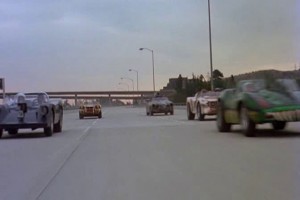
So, I’ve argued before that it isn’t necessary for a film to have a character called Frankenstein in it in order to be a Frankenstein movie. Is the reverse true? Death Race 2000 seems on first glace to suggest that it is. It has a character called Frankenstein, but rather than being a mad scientist or a monster he is a racecar driver. Is he a Frankenstein, though? Well, this is one of the strongest metaphors in a rather spotty movie. Frankenstein is used here as a metaphor for celebrity. David Carridane’s character may me a real person in some ways, in others he’s a purely artificial being. He’s put together by Mr President for a specific purpose, made out of the ruins of past celebrities. In the end, though, he turns against his creator, more like a Frankenstein Monster than your average celebrity.
There’s also an interesting parallel with the 1931 film version of Frankenstein. Carradine’s Frankenstein confronts and then kills an innocent girl. In the original version this is caused by a tragic miscommunication, whereas in this film both parties understand perfectly what is going on. Laurie (Wendy Bartel) meets Frankenstein after the first leg of the race, and introduces herself as a member of the local Frankenstein fanclub, and tells him a little about herself. The following day, she deliberately stands in his road and is run down. It’s a creepy moment in an otherwise silly film, parodying aspects of the cult of celebrity whilst also explaining why Frankenstein is so keen to escape his role.

Like most films of this sort, Death Race 2000 works on the premise that the evil government needs gladiator fights to distract the populace, but this creates a class of enslaved warriors who would be eager to use their gladiatorial prowess against their masters. So I guess the best bet of the ruling elite would therefore be to create some system of distracting the populace that doesn’t involve ferocious human killing machines. Like if you took some people who wouldn’t be very good at death-racing or pit-fighting—Kim Kardashian for example or Johnny Depp—and somehow used them as a means of distracting the populace.
Oh. Oops! Oh, well.
Death Race 2000 also runs into the same difficulty that a lot of films of the ‘in the future we’ll fight to the death in gladiator contest’ sort of films go, from Rollerball to the Hunger Games. Namely, it has to tread the line between ‘how awful would that future be?’ and ‘how awesome would future gladiators be?’ Death Race 2000 mostly gets around this difficulty by making the death scenes look pretty dorky and silly rather than awesome, which helps avoid the pitfall of making its dystopia look too appealing.
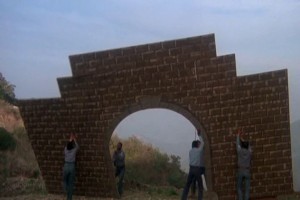
Throughout the movie, there are a trio of race reporters, the excitable Junior Bruce (Don Steele), the obsequious Grace Pander (Joyce Jameson) and the deadpan Harold (Carle Bensen). They act partly as a Greek chorus, partly as unreliable narrators, explaining to us how Mr President would like us to view the unfolding events – blaming resistance attacks on the French, for example. At the very end, though they turn on us. After Frankenstein bans the race, Junior Bruce makes the (pretty fair) point that this is hypocritical, given that Frankenstein’s popularity comes from his history as a racer. Frankenstein defers the question to his press secretary. Harold tells Junior to back off, and Junior replies ‘it’s the Race, man!’
This I find interesting. It implies that in spite of his former role as the mouthpiece of a repressive government, he is not in fact a dishonest person. He wasn’t just encouraging the populace to enjoy their bread and circuses to make them politically quiescent, he was promoting something he genuinely enjoyed. And this is, I think, a neat piece of self-satire on the part of the filmmakers. It’s one thing to decry ‘bread and circuses’, but bread is delicious and circuses are actually pretty neat.
Not counting the clowns, obviously. Or poodles that walk on their hind legs, they’re just creepy.
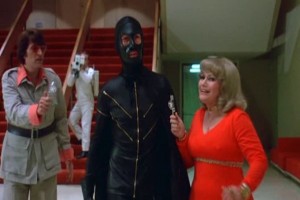
And what of the populace, brainwashed by Mr President?
Other than the weird quasi-religious fanaticism of Laurie and a couple of shots of cheering crowds, we don’t get much of an idea about what they think. I wonder why not. Perhaps it ruins the distance. After all, those of watching this movie are enjoying the sight of crazy cars running people over and blowing things up. We are basically the average people of the Death Race 2000 universe, and what does that say about us?
Note that if you haven’t watched this movie or a similar one, it probably says nothing about you. Also if you watched this movie and didn’t enjoy it. Or if you watched it and you still feel that you’d object to a totalitarian government… Actually, you know what? Forget I said anything.
